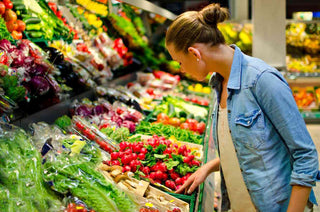As we head out of winter and into spring, why not track our progress with those New Year’s resolutions? And what better time to reflect on our healthy eating habits than in March, which just happens to be National Nutrition Month?
We all know the best healthy-eating, good nutrition move you can make is simple: eat more vegetables. And thankfully, this seems to be happening…for some of us, at least.
“People aged 40 and under are consuming 52% more fresh vegetables and 59% more frozen vegetables compared to a decade ago.”
Recent market analysis shows that people aged 40 and under are consuming 52% more fresh vegetables and 59% more frozen vegetables compared to a decade ago, revealing a greater preference for fresh, local, and in-season food versus premade, pre-packaged convenience food.
Unfortunately, the same research shows that older Americans aged 60 and up decreased consumption of fresh vegetables by 30% and frozen vegetables by 4% over the same period.
Research from the past three decades indicates that vegetable consumption increases with age, so the prediction is that fresh vegetable consumption will increase another 10% overall over the next several years and frozen vegetable consumption will increase by about 3% through 2024.
But we’re still eating fewer vegetables than we were 25 years ago, so while progress is being made, we can still do better for our bodies.
Easy Tips For Eating More Veggies
Vegetables provide key nutrients like calcium, folate, iron, magnesium, potassium, vitamin A and vitamin C. Plus, they’re a great source of fiber, which helps prevent obesity, diabetes and cardiovascular disease.
To maximize nutrition and convenience, here are some ways to increase your vegetable consumption:
Buy What’s In Season
It’s still winter in most parts of the country, and the vegetable aisle may have slim pickings. This spring, look for vegetables like artichokes, asparagus, endive, broccoli, butter lettuce, collard greens, fennel, green beans, morel mushrooms, mustard greens, peas, radicchio, red leaf lettuce, rhubarb, snow peas, spinach, Swiss chard, Vidalia onions, and watercress.
Buy Locally Grown
Locally grown vegetables don’t travel as far, making them more earth-friendly. They are also picked at their peak, which maximizes both nutrients and taste. You can shop at your local farmer’s market for fresh, local produce, or look for signs at the supermarket that tout this benefit.
Fresh Not Available? Buy Frozen
Frozen vegetables are just as nutritious as fresh – great news for those of us who can’t access fresh vegetables all the time or who want to eat certain veggies that aren’t available at the time.
Don’t Stress Over Organic
Depending on where you live and shop, the options for organic produce may not be great. But in some cases it’s less important. The Environmental Working Group’s “Clean Fifteen” include avocados, sweet corn, cabbage, frozen sweet peas, onions, asparagus, eggplant, and cauliflower. If you’re worried about pesticide residues, the vegetables you should always try to buy organic include celery, spinach, tomatoes, sweet bell peppers, and cucumbers.
Buy For Convenience
Pre-washed, bagged vegetables like lettuces, peeled squash, broccoli and cauliflower florets, and trimmed green beans cut down on prep time, making them easy to grab and cook or even grab and eat. They might cost a little bit more, but you’re far more likely to eat them instead of letting them spoil in the fridge for lack of prep time.
Try a New Vegetable Each Month
Only eat zucchini? There are plenty of other types of squash to try including spaghetti, delicata, and acorn. Love your salads? Switch it up by using a different kind of leafy green like kale, tatsoi, mizuna, or endive.
10 Easy & Healthy Salad Recipes
Try New Cooking Techniques
If you think veggies only are boiled, mushy and tasteless, think again!
Roasting is a simple, tasty way to prepare vegetables. Many root vegetables like parsnip, carrot, and sweet potato, are excellent roasted. So are cruciferous vegetables like broccoli, cauliflower, and Brussels sprouts. Just slice, toss with a bit of olive oil, pepper, salt and roast at 350 degrees for 30-40 minutes.
For vegetables like brocollini or green beans, lightly steam the vegetables first so they are cooked al dente. In a sauce pan, on medium heat, add 2 tablespoons of olive oil, a teaspoon of anchovy paste, a teaspoon of diced garlic. Add the steamed vegetables and toss for about 1 to 2 minutes, seasoning with ground pepper, salt and red pepper flakes.
Wilt vegetables like spinach and rainbow chard in a pan with a little olive oil, and season with salt and pepper. If you’re feeling fancy, you can add a bit of garlic or a squeeze of lemon.
And if you’re a soup lover, you can always throw a bunch of vegetables into a healthy, soul-warming soup.
Soup’s On: 15 Favorite Soup Recipes
Replace a Starch with a Veggie
Instead of serving carb-heavy rice, pasta, or potato as a side-dish, load up on another vegetable. Not only will it be more nutrient-dense, it’ll help you feel fuller thanks to the fiber.
While young people aren’t usually thought of as role models, especially when it comes to behavior and habits, it looks like times are changing – they’ve now developed eating habits the rest of us could benefit from following.
So let’s take a cue from the Millennials and make it a goal to eat more veggies this month and the rest of the year.

